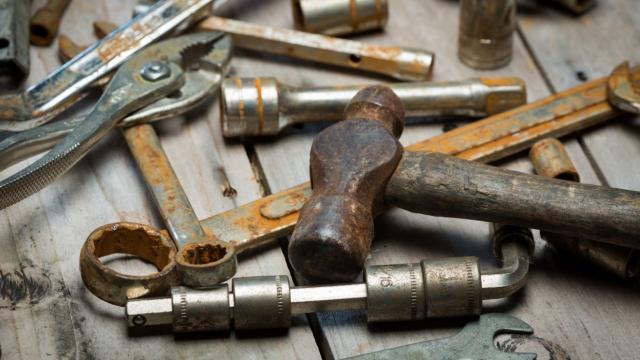Rusted tools, cars, bolts or even your stainless steel appliances can often be salvaged—if the rust is caught early enough. At those early stages, rust is more of an aesthetic issue and an annoyance. But rust is a process of corrosion that will eventually render its victims unusable and unrepairable, making any effort to clean them up and protect them against further ruin a waste of time. The trick is knowing when rust has won and you’re better off replacing that car panel, old power tool, or kitchen utensil.
Stages of rust
The first thing to know is that rust goes through several distinct stages as it quietly consumes your beloved stuff:
- Surface rust. The earliest stage of rust shows up as isolated reddish-brown patches, often quite small. This surface rust is generally harmless and doesn’t penetrate below the surface of the metal, so it can be scraped away pretty easily—and if you take steps to protect the metal by keeping it away from moisture and adding a coating of lubrication (WD-40 will work), it will be just fine.
- Scale rust. If left to its own devices, the rust will keep eating away at the iron in your tool or component. The brown, dusty discoloration will spread—but more importantly, pitting will start to show up. These tiny pinpricks in the metal are where the rust process has started to invade below the surface. Your stuff can still be saved, but it’s going to take more work.
- Structural rust. At this stage, literal holes have begun to appear in the metal. In sheet metal, like a car panel, this usually means the metal is thin and papery, and might have been eaten away entirely. In thicker components, the structural integrity may still be viable, but the pitting is probably so severe that any attempt at repair will be futile.
If the rust is very severe, you can often tell visually—at a glance—that the thing you’re trying to save is a lost cause. But with more complex things, like tools, it sometimes takes a bit more investigation.
Assessing rust
When it comes to rusted stuff, the “lost cause” stage often depends on its role. Car panels, for example, are usually designed more for aesthetics than safety or strength, and thus can often be filled in, sanded, and painted, and still perform their basic functions. Stuff like metal furniture that gets badly rusted can often be salvaged by applying a rust-specific primer that stops the oxidation process.
For anything that requires a high level of strength, like a car’s rocker panels or tools, however, cosmetic repairs won’t be sufficient. A few considerations:
- Pitting. If the metal is visibly pitted and etched by rust, the process of reduced structural integrity has already begun. If the component is intended to be load-bearing or needs to apply a lot of torque (like a wrench or power drill), severe pitting is a sign that it probably needs to be replaced.
- Thickness. The use and thickness of the metal is a factor, too. A hammer that’s suffered a lot of rust may still be usable as long as a stable core remains in the head and you repair it properly. A badly rusted drywall knife, on the other hand, might not be salvageable at the same level of damage.
- Power tools. If rust on a power tool has compromised its moving parts, it can be dangerous to operate even if you manage to remove the caked-on surface rust and get it moving again. A good rule of thumb is if the power tool won’t initially work due to thick rust deposits, it’s probably best to just replace it unless you’re willing to put in a lot of work to salvage it.
Lead Image Credit: Shutterstock

Leave a Reply
You must be logged in to post a comment.